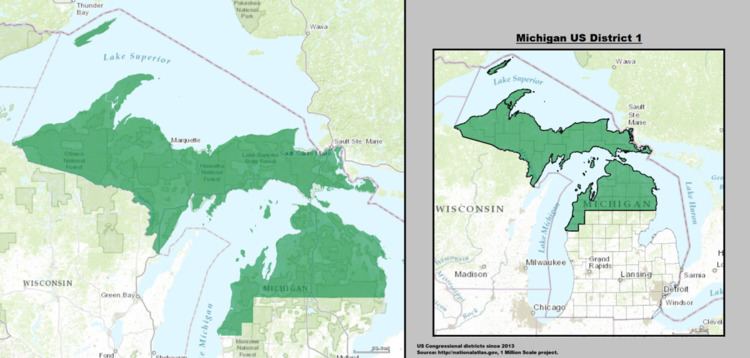Population (2010) 705,974 Area 64,426 km² | Cook PVI R+4 | |
 | ||
Ethnicity 92.1% White1.3% Black1.4% Hispanic2.8% Native American | ||
Tv ad gary mcdowell in michigan s 1st congressional district
Michigan's 1st congressional district is a United States Congressional district containing the entire Upper Peninsula of Michigan and 16 of 21 counties of Northern Michigan in the Lower Peninsula. The district is represented by Republican Jack Bergman.
Contents
- Tv ad gary mcdowell in michigan s 1st congressional district
- Geography
- History
- Major cities in the district
- Elections
- References
Geography
The district is the second-largest congressional district east of the Mississippi River by land area, behind Maine's 2nd congressional district. Its boundaries contain much of the northeastern part of the Lower Peninsula in addition to the entire Upper Peninsula. Altogether, the district makes up about 44% of the land area of the state of Michigan. It contains the second-longest shoreline of any district in the United States, behind Alaska's At-large congressional district.
Of the 83 counties in Michigan, 30 lie fully within the district, and it contains a portion of another.
History
Prior to 1992 the 1st Congressional District was a Detroit-based congressional district. (For most of the time prior to 1992, the territory now in the 1st District was in the 11th district.) From the election of Republican John B. Sosnowski in 1925 until 1964 the former 1st district was represented by only one non-Polish-American politician, Robert H. Clancy. Along with Sosnowski, 6 Polish-Americans served as the 1st district's representatives elected 7 times, since 1925. The other strong Polish Michigan congressional districts were the 15th district (where half of the elected were Polish-American) and the dissolved 16th district (where all three elected representatives were of Polish descent). In 1964 the 1st Congressional district was drawn as a new, African-American majority district reflecting the changing demographics of Detroit, while enough of the old 1st district was moved to the 14th district that that district retained the 1st's old congressman. John Conyers was elected to congress from the 1st district, a position he would hold until the 1st was removed from Detroit.
After 1992, the 1st district cover land in the UP and Northern Michigan. The 1st from 1992–2002 was similar to the present district, except that it did not extend nearly as far south along Lake Michigan, while it took in Traverse City and some surrounding areas on the west side of the state.
